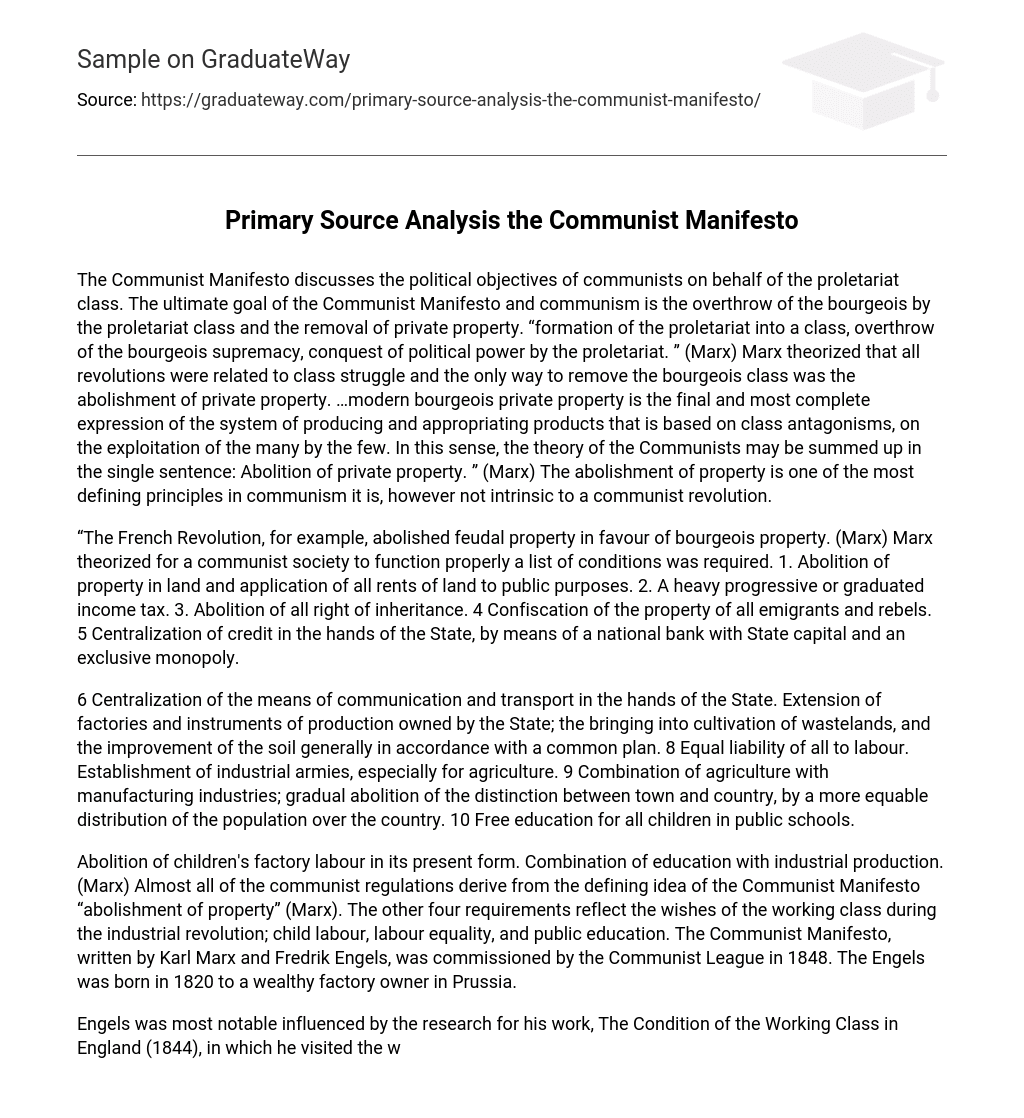The Communist Manifesto discusses the political objectives of communists on behalf of the proletariat class, with the ultimate goal being the overthrow of the bourgeois by the proletariat class and the removal of private property. According to Marx, essential elements for achieving this are forming a class-conscious proletariat, overthrowing bourgeois supremacy, and gaining political power. Marx theorized that all revolutions stem from class struggle and that abolishing private property is necessary to eliminate the bourgeois class. He argued that modern bourgeois private property represents a system built on exploitation and class antagonisms. Consequently, communism’s theory can be summarized as advocating for the abolition of private property. However, it is crucial to note that while eliminating property is a defining principle in communism, it may not always be intrinsic to a communist revolution.
The French Revolution eliminated feudal property and promoted bourgeois property. Marx believed that for a communist society to work well, specific requirements had to be fulfilled. These requirements encompassed the elimination of land ownership and redirecting all land rents towards public uses. Additionally, Marx advocated for a progressive income tax system, abolishing inheritance rights, seizing property from emigrants and rebels, and consolidating credit through a state-controlled national bank holding a monopoly.
6 Centralization of communication and transportation under government control. Expansion of state-owned factories and production facilities; utilization of uncultivated land and soil enhancement in accordance with a collective strategy. 8 Universal labor obligations. Creation of labor forces dedicated to agriculture. 9 Integration of agriculture and manufacturing; gradual dissolution of urban-rural divide through more equitable population distribution across the nation. 10 Universal access to cost-free education for all children attending public schools.
Marx suggests that the solution to end children’s factory labor is the combination of education and industrial production. The concept of abolishing property, as outlined in Marx’s Communist Manifesto, forms the basis for many communist regulations. During the industrial revolution, the working class desired an end to child labor, equal treatment in work, and public education. These desires are reflected in four remaining requirements stated in the manifesto. The Communist Manifesto was written by Karl Marx and Fredrik Engels under commission from the Communist League in 1848. Engels, born in 1820 to a prosperous factory owner in Prussia, played a role in its creation.
Both Engels and Marx were influenced by their research for their respective works. Engels explored the worst districts of Manchester in The Condition of the Working Class in England (1844), while Marx was exposed to socialism in revolutionary France and the industrial revolution. These experiences greatly impacted both of them. In his critique of private property, Marx drew inspiration from Pierre-Joseph Proudhon and Jean-Jacques Rousseau. Despite not being members of the proletariat class themselves, both Marx and Engels consistently advocated for workers’ rights. It is important to note that Communists do not oppose other working-class parties; instead, they align their interests with those of the proletariat as a whole.
According to Marx, the Communist Manifesto does not offer distinct principles for guiding the proletarian movement. Instead, it is a transparent document that explicitly rejects concealing one’s opinions. The manifesto openly states that the violent overthrow of existing social conditions is crucial for achieving its objectives.
Marx posits that the ruling classes should be fearful of a Communist revolution because the proletarians possess nothing to forfeit except their chains and have the potential to acquire an entirely new world. The Communist Manifesto, intended for socialists during a period when revolutionary Europe was concluding, asserted Marx’s belief that the capitalist system is fundamentally flawed, rendering it unfeasible for socialists to enact change from within. Socialists at the time enthusiastically embraced the Communist Manifesto, resulting in Russia becoming the inaugural communist nation in 1917. Revolutionaries and members of the proletariat class comprised the primary advocates of this manifesto.
Governments, bourgeoisie, and factory owners vehemently opposed socialism and communism, particularly after the formation of the USSR. The concept of transitioning from capitalism to communism was introduced in the Communist Manifesto, capturing a wider audience beyond socialists. Marx identified uniting proletarians worldwide as the fundamental aspect of communism, placing emphasis on their collective interests over nationality (Marx).
The creation of a party that serves the proletariat, regardless of nationality, demonstrates Marx’s intention for a global revolution. Although Marx’s theory of a global revolution did not come true, socialist legislation was implemented shortly after. However, countries like Russia, China, Vietnam, North Korea, and Cuba experienced a communist revolution, but only a few have endured and none have succeeded. The Communist Manifesto has transformed the perception of socialism.
Bibliography
Marx, Karl, and Friedrich Engels wrote “Proletarians and Communists” in The Communist Manifesto (1985) published by Penguin in London.





